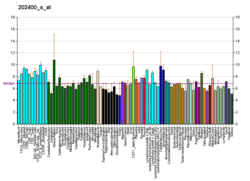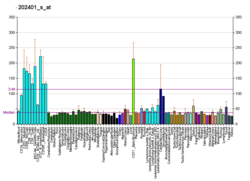Serum response factor, also known as SRF, is a transcription factor protein.[5]
Function
Serum response factor is a member of the MADS (MCM1, Agamous, Deficiens, and SRF) box superfamily of transcription factors.[6] This protein binds to the serum response element (SRE) in the promoter region of target genes. This protein regulates the activity of many immediate early genes, for example c-fos, and thereby participates in cell cycle regulation, apoptosis, cell growth, and cell differentiation. This gene is the downstream target of many pathways; for example, the mitogen-activated protein kinase pathway (MAPK) that acts through the ternary complex factors (TCFs).[7][8]
SRF is important during the development of the embryo, as it has been linked to the formation of mesoderm.[9][10] In the fully developed mammal, SRF is crucial for the growth of skeletal muscle.[11] Interaction of SRF with other proteins, such as steroid hormone receptors, may contribute to regulation of muscle growth by steroids.[12] Interaction of SRF with other proteins such as myocardin or Elk-1 may enhance or suppress expression of genes important for growth of vascular smooth muscle.
Clinical significance
Lack of skin SRF is associated with psoriasis and other skin diseases.[13]
Interactions
Serum response factor has been shown to interact with:
See also
References
Further reading
- Esnault C, Stewart A, Gualdrini F, East P, Horswell S, Matthews N, Treisman R (May 2014). "Rho-actin signaling to the MRTF coactivators dominates the immediate transcriptional response to serum in fibroblasts". Genes & Development. 28 (9): 943–58. doi:10.1101/gad.239327.114. PMC 4018493. PMID 24732378.
- Huh S, Song HR, Jeong GR, Jang H, Seo NH, Lee JH, Lee TH (Feb 2018). "Suppression of the ERK–SRF axis facilitates somatic cell reprogramming". Experimental & Molecular Medicine. 50 (2): e448. doi:10.1038/emm.2017.279. PMC 5903827. PMID 29472703.
- Pellegrino R, Thavamani A, Calvisi DF, Budczies J, Neumann A, Geffers R, et al. (January 2021). "Serum Response Factor (SRF) Drives the Transcriptional Upregulation of the MDM4 Oncogene in HCC". Cancers. 13 (2): 199. doi:10.3390/cancers13020199. PMC 7829828. PMID 33429878.
- Hu X, Wu Q, Zhang J, Kim J, Chen X, Hartman AA, et al. (January 2021). "Reprogramming progressive cells display low CAG promoter activity". Stem Cells. 39 (1): 43–54. doi:10.1002/stem.3295. PMC 7821215. PMID 33075202.
- Kepser LJ, Khudayberdiev S, Hinojosa LS, Macchi C, Ruscica M, Marcello E, et al. (February 2021). "Cyclase-associated protein 2 (CAP2) controls MRTF-A localization and SRF activity in mouse embryonic fibroblasts". Scientific Reports. 11 (1): 4789. Bibcode:2021NatSR..11.4789K. doi:10.1038/s41598-021-84213-w. PMC 7910472. PMID 33637797.
External links
- Serum+Response+Factor at the U.S. National Library of Medicine Medical Subject Headings (MeSH)
- FactorBook SRF
This article incorporates text from the United States National Library of Medicine ([1]), which is in the public domain.






